Top tips for fermenting your own kombucha, kefir and kimchi at home
Kombucha, kefir, kimchi — fermented food is one of the hottest health buzzwords. Dan Stock takes a look at the 21st-century revival of the ancient craft of fermentation.
Whether you’re drinking in a cool bar, eating at a hot new restaurant or even shopping in the supermarket these days you’ll see three words everywhere: kombucha, kefir and kimchi.
And while they are three very different products they have one thing in common: they are the created through fermentation, one of the biggest food trends of the past few years.
At its simplest, fermentation is a process of preserving food so it can be eaten in future – something humans have done since time memorial, whether by drying or pickling, curing or burying underground.
YOUR GUIDE TO THE MELBOURNE FOOD AND WINE FESTIVAL
FOODIE FESTIVAL EXPANDS ITS HORIZONS
WHAT’S HOT FOR VICTORIAN FOOD LOVERS IN 2019

There are countless products of fermentation — beer and wine being the most obvious, but cheese and yoghurt, sauerkraut, soy sauce and sourdough are as well — that are created through a process where microbes such as yeasts, bacteria and moulds break down and transform the molecules in the food.
This ancient cooking technique is having a modern revival due to a renewed interest in “living food” — specifically food that helps maintain a healthy digestive system through “good” bacteria.
One of the world’s leading chefs, Rene Redzepi, used various fermentation techniques to propel his restaurant, Noma in Copenhagen, to being the best in the world, and has just released a tome for the professional chef and home hobbyist alike documenting that journey in The Noma Guide to Fermentation.
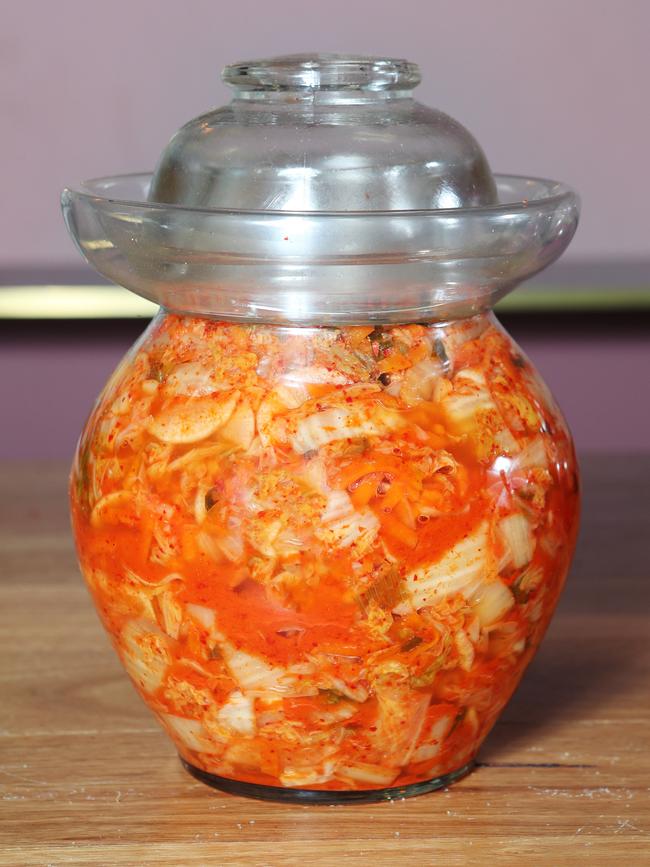
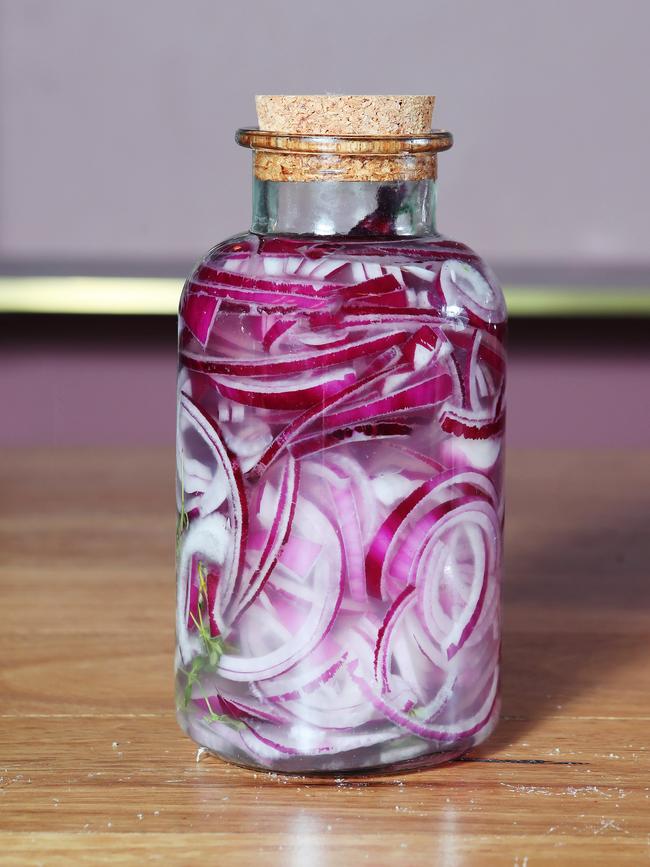
But closer to home, Sharon Flynn from The Fermentary in Daylesford has been leading the fermented food charge, beginning her “microbial journey” initially as a way to help heal her sick daughter’s antibiotic-ravaged tummy.
“When I got into fermenting it was about gut health, but then I started looking into it more and realised it’s about flavour. We’re being ripped off with the flavour of products that once were fermented but are now manufactured industrially,” she says. “Fermentation takes time, and time is the enemy of food manufacturing.”
As Rene Redzepi writes in his book: “Once you have these incredible products at your disposal cooking gets easier while your food becomes more complex, nuanced and delicious. People argue over the correlation between fermented foods and an active gut health. But there’s no denying that I personally feel better after eating a diet full of fermented products.”
FIRST STEPS
Fermentation is a process of “controlled rot”, Sharon says. “There’s a fine line between fermentation and rotting, we want to get rid of those bacteria that cause rotting.”
They are generally salt-hating or oxygen-loving bacteria, so using salt to preserve, and shutting out the air will give you a delicious ferment. There’s little that can go wrong with creating a ferment in a clean environment, Sharon says, but if you get black or pink mould on your ferment, you should discard and start again.
“Use your senses. If your kraut is soggy and smells eggy then it’s probably not a good batch and you should get rid of it.”

EQUIPMENT
This is a very simple, ancient process, so don’t get too caught up in buying expensive equipment, Sharon says – a jar, something to “pound” the vegetable into it, and something to weigh it down, is all you need.
Carbon dioxide, which is the result of a happy ferment, needs to escape from the jar, otherwise there may be spills, breaks or seeps. A jar with lid is the simplest, just leave enough “head” room and remember to “burp” your ferment every day (take lid off to release the gas)
Sharon says an air lock system will give you a predictable ferment. Pick up an S bend air lock at home brewery shops, and fit into a drilled hole in a normal jar lid, with a rubber stopper.
A “follower” is a liner – simply something placed over the top of the vegetables before the weight, to help keep the vegetables down. It should be non-reactive and clean – like a cabbage leaf, or plate.
For the weight, Sharon says a large rock is great - just boil it for about 10 mins to get rid of any dirt –or use a muslin bag with pie weights in it.
COOL KRAUT
To make a kraut – fermented cabbage – all you need is salt and a good cabbage. That’s it, Sharon says.
However, there are a couple of key things to remember. Firstly, weigh your cabbage – look for a heavy cabbage as you want one dense with liquid, as this will help keep the oxygen out of the jar – and then chop it into consistent sizes.
Use the finest, highest grade salt you can – you’ll need 1.5-2% salt to cabbage. Massage this into the cabbage in a large bowl, using a wooden muddler or rolling pin, or simply use your hands.
Massage for around 10 minutes, until the cabbage is juicy and shiny. “When you grip it, it will drip with water, that’s when you can stop,” Sharon says.
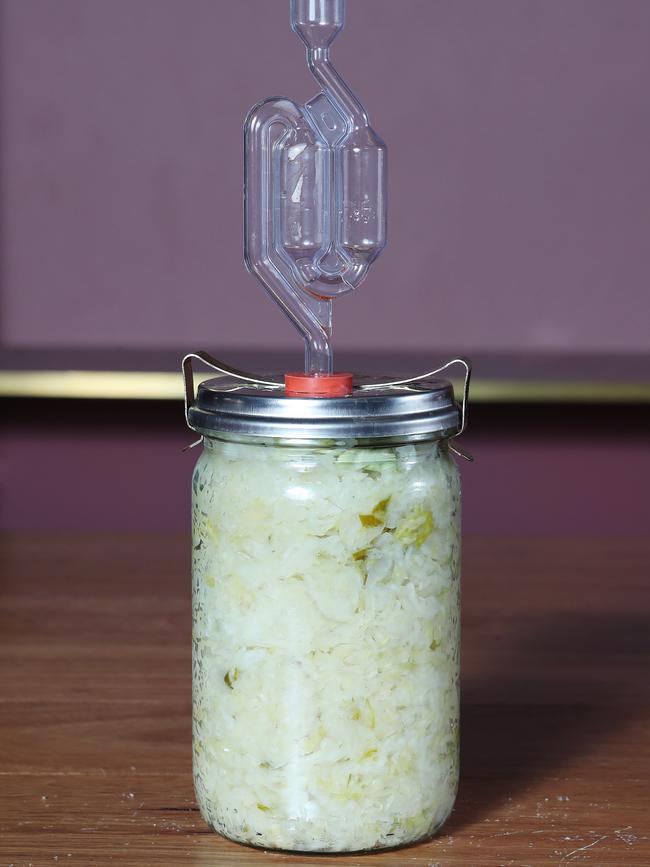
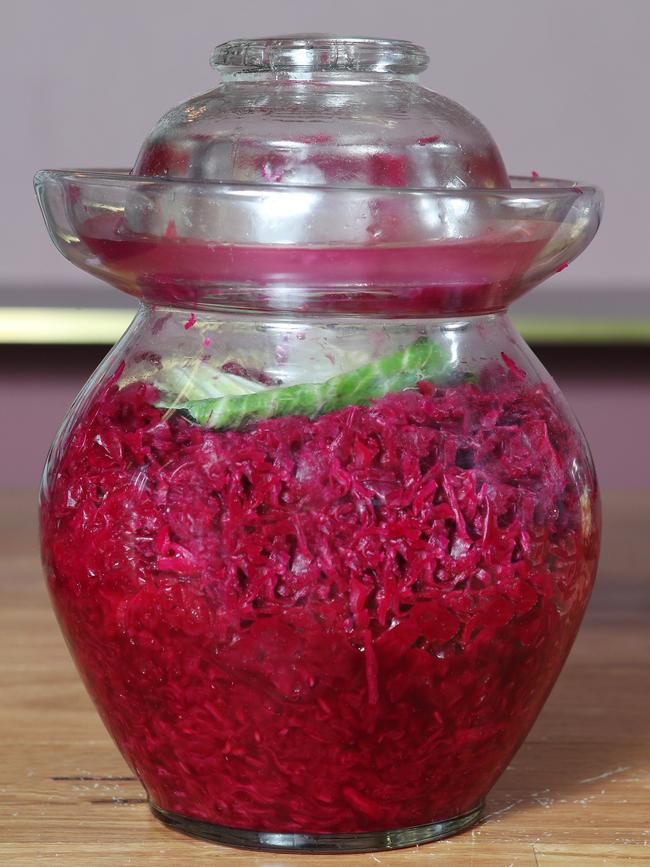
Next, when you put the cabbage into the jar (dishwasher clean is fine) it has to be packed very tight, pushed down with the muddler after each handful of cabbage. You want to get rid of any air pockets.
As gas is released during the ferment, leave about 10 per cent of the jar free - the more headroom, the less likely it will be to leak. Store at room temperature.
Sharon says the kraut should be “satisfyingly sour” within two weeks. Keep tasting over the next week or two and when it’s as sour as you like, clean the lid, replace, and keep your kraut in the fridge, where it will last for up to a year.
FLAVOUR SAVOUR
Once you’ve perfected your basic kraut, you can start experimenting with flavouring it.
Once your cabbage is dripping add your choice of flavour – about half the amount of salt.
Popular combinations include red cabbage with fennel seeds, green cabbage with juniper berries and caraway seeds, or turmeric with black pepper and ginger.
BEAN SCENE
The simplest ferment you can do is a brined veg, and green beans are deliciously sharp and crunchy when treated this way.
Top and tail the beans, taking any stings and black bits off. Pack your jar tightly, along with any flavours – dill, bay leaf, garlic and chilli all work well – and cover with brine made from 1 large tbsp fine salt per litre of water. Cover with the “follower” and weigh down.
This is a fast ferment – it will only need between 3 and 5 days at room temperature – and then you have pickled beans that are crunchy, sour and delicious. These will keep in the fridge for up to eight weeks.
CRUNCH TIME
Other veg that are popular to ferment include carrots – either whole baby carrots or cut into rounds – cauliflower cut into florets, red onion, and, of course, cucumbers that are turned into true pickles.
Veg that don’t work include those with high chlorophyll - kale, spinach – or with thin skin and a high water content, such as zucchini.
Sharon also ferments garlic in raw honey, which produces a “lovely caramelised garlic you can spread, and a sweet, garlic liquid you can use as a tonic, drizzle on lamb chop, or on cheese”.
HOT STUFF
A newfound love of Korean food put kimchi on our plates – and our palates – over the past few years and making your own is a great next step on the fermentation journey, Sharon says.
You’ll need to make a paste made from gochugaru – Korean chilli powder – raw sugar, garlic, ginger, tamari and fish sauce.
Chop your wombok and salt as you would a kraut and leave overnight. Discard the water – unlike kraut you don’t want to this to dilute the flavour of your kimchi – then cover the wombok with the paste, massaging in, before adding to the jar packing tightly as you go. This is a fast ferment, ready for the fridge in five days.

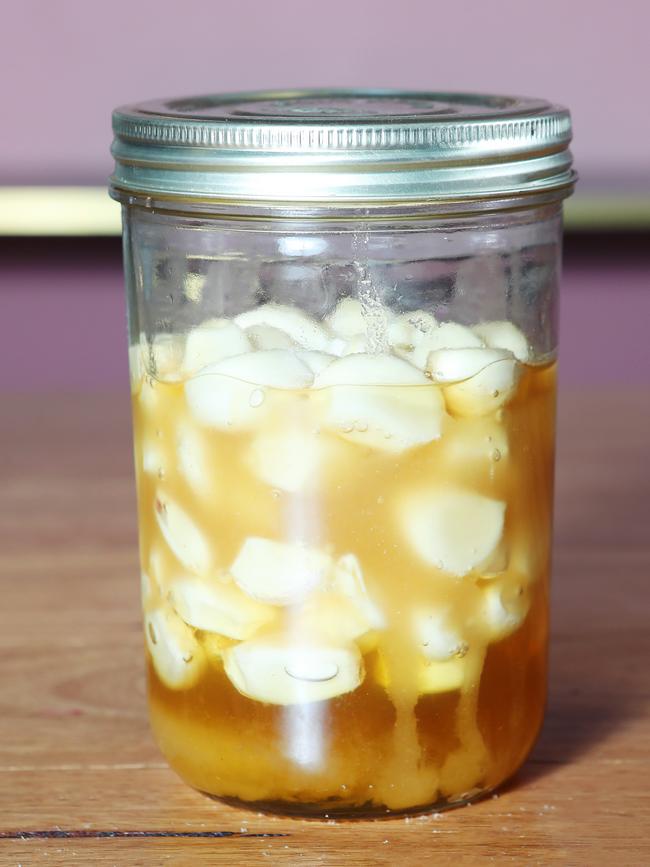
NEXT STEPS
Sharon says the next level of fermenting fun involves a SCOBY – which stands for symbiotic colony of bacteria and yeast – which is used to create kombucha, jun, water kefir and milk kefir.
“It’s the next level of commitment, but there’s an everyday magic in your kitchen,” she says.
DO THIS
As part of this year’s Melbourne Food and Wine Festival, Sharon will hold a Fermentation 101 workshop on day two of the festival’s opening weekend House of Food and Wine program of masterclasses, talks and top-notch drinking and dining. General admission day passes from $65 (workshops extra). She’ll also join Palermo chef Ollie Gould for a dinner celebrating all things raw, wild and live on March 20 at Palermo gets Pickled ($106). For all tickets MFWF.com.au
The Fermentary holds workshops throughout the year. For details, thefermentary.com.au
RECIPE
Carrot, turmeric and ginger kraut
Prep: 20-30 mins
Fermentation: 2-3 weeks
Equipment: 2L jar, pounder, follower, weight
Ingredients:
1 green cabbage, shredded
310g grated carrot
About 20-30g fine ground salt
2.5cm fresh ginger, finely grated
5cm turmeric, grated
1 tbsp ground black pepper
1 tbsp cumin seeds
Method:
Weigh the cabbage and carrot and determine the salt measurement (1.5-2%)
Transfer cabbage to a large bowl or container, sprinkle over salt and let sit. Pound or massage to get all of the juices out – ideally enough so that if you pick up a handful of cabbage you’ll have dripping water flowing from a clenched fist. Add the carrot and other ingredients and mix thoroughly. Pack tightly into your jar or crock, add the follower and weigh down. Seal with your preferred method. Wait. Check for flavour after about five days. Refrigerate when ready – this usually takes 2-3 weeks. It will keep in the fridge for up to 12 months.
From: Ferment for Good: Ancient foods for the modern gut. By Sharon Flynn (Hardie Grant)
Sharon says the kraut should be “satisfyingly sour” within two weeks. Keep tasting over the next week or two and when it’s as sour as you like, clean the lid, replace, and keep your kraut in the fridge, where it will last for up to a year.

